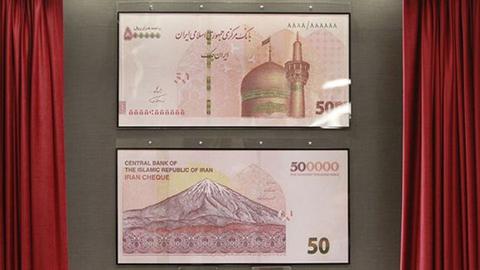It has been 89 years since the Iranian parliament set the rial as the country’s official currency on February 26, 1930. Then, the law set the value of the rial equal to 0.3,661,191 gram of pure gold [Persian link]. On January 9, 2019, the same amount of gold was worth 1.671 million times more.
From the middle of the Qajar dynasty (1798-1928) until 1932, the official Iranian currency was the toman. It is understandable that when Reza Shah Pahlavi overthrew the Qajars in 1925 he changed the currency, but it is not quite clear why he chose the rial. The currency had been circulating in southern Iran since the early 16th century, when the Portuguese Empire occupied the Persian Gulf island of Hormuz, but it had never been Iran’s currency. The Pahlavi government, however, was adamant about doing away with the Qajar currency and on March 13, 1932 it was decided that, starting on September 23 of that year, toman banknotes and “qiran” coins — each worth one-tenth of a toman — would no longer be valid and that one Pahlavi rial would replace one Qajar qiran.
Since then all official accounts have been calculated in rials — from government budgets and price estimates to accounting documents and statements by state-owned and private companies. But what is interesting that the rial was never popular among the people. Under the Pahlavi monarchy and the Islamic Republic, no one referred to “one rial” instead of “one qiran” or “ten rials” instead of “one toman.” Except on paper, nobody recognizes the rial, as though it is a symbol of official hypocrisy, like other bureaucratese words and expressions that are valid only on paper.
For nearly 90 years now, Iranians have preferred to divide the numbers by ten and arrive at tomans rather than use the uninvited “rial.”
One Country, Two Currencies
Iran is unique in the sense that it uses two currency units for the same money. However, except for those engaged in commerce, currency exchanges and businesses that deal with foreign tourists, ordinary people have no need to convert these currency units from one to the other. They simply divide the official currency by 10 to get a feel for it and communicate it to each other. For example, if the sticker on a piece of merchandize announces its price as 100,000 rials, it has no meaning until it is divided by 10 and becomes 10,000 tomans.
For bigger numbers, however, this turns into a more difficult job. For instance, when the government budget specifies that the allocation for a certain organization is 10 billion and five hundred million rials, this does not hold significance for anyone until it is divided by 10 and becomes one billion and 50 million tomans.
For years now, the rial has been a serious headache for financial dealings in Iran. For all practical purposes, incomes are received in tomans and expenses are paid in tomans, and yet in official ledgers, a zero must be added to each figure, making accounting more difficult, as well as increasing the chances for errors. Consequently, discussions about changing and “reforming” the currency unit has been going on in Iran for years — particularly in the last 25 years.
In 2007, the move toward reform became more serious, and the government even set up a website to conduct a public opinion poll. And recently there has been talk of removing four zeros from the national currency and replacing every 10,000 rials with one toman. However, there has not been any official annoucement or confirmation that this will happen.
A Boon or a Pipe Dream?
But if officials did take steps to rename the currency, calling it by the name everyone knows it by and removing a zero to conform with how people deal with money anyway, this could lead, at the very least, to less confusion. But in Iran, when it comes to economic or financial matters, it is never straightforward or simple.
Inflation has been rising for months, and the government shows no sign of being able to control it. In November 2018, the average price index was one and a half times higher than the average for November 2016. Zeros have been added to prices, symbolizing both the depth of the economic crisis and the level of mistrust people feel toward the national currency.
Even when the Iranian currency was relatively strong against the dollar at one point in 2018, it became a source of embarrassment for Iranians. After the effect of US sanctions hit the economy, the price of the dollar fell from breathtaking heights to 10,000 tomans, but money exchange businesses still had to add five zeros in front of one rial. And when the price of a loaf of bread in Iranian cities rose to 20,000 units of the national currency, it was easy to sense a psychological pressure as well.
In September 2018, the Iranian Central Bank announced that the level of liquidity in Iran was 16,938.4 trillion (16,938,400,000,000,000) rials, meaning that Iranians were experiencing the complex reality of dealing with trillions and quadrillions — numbers difficult to enter into common calculators and difficult to multiply and divide. In such a situation, shaving off four zeros would make life simpler. For instance, the price of one dollar would then become 10 currency units (tomans), a loaf of bread would cost two currency units (tomans) and the volume of liquidity would be 1,694 billion currency units (tomans). These figures would be both easier to understand and to calculate and the psychological impact would be less stressful too.
The most significant benefit of reforming the national currency would be to simplify accounting, which could have many advantages in the long run. However, in the short run it would entail immediate and direct costs — from collecting banknotes and notes and printing new ones to the cost of converting ledgers, financial documents and statistics. The cost-benefit analysis depends on a few variables. What would be the time span for calculating benefits? Would the value of the national currency fall with the passage of time or stay stable? Would the new currency be brought down to the value of the current currency, and when? And given that some people worry that zeroes would have to be added in anyway, the psychological and economic impact could potentially be much worse.
In Venezuela, for instance, only a few months after the government removed zeroes from its currency (the bolivar), the zeros returned — the continued fall in the value of the bolivar made the adoption of the new currency useless. In Turkey, however, this was not the case. In 2004 each US dollar was worth 1.35 million liras but in 2005 Turkey removed six zeros from its currency and even after the fall in the value of lira in the summer of 2018, a dollar was worth less than 5.5 liras.
A Historical Necessity in the Worst of Times
History shows that currency reform can play a positive role when it is done in a stable and flourishing economy, but it has often proved costly in an economic crisis and in many cases has only deepened that crisis.
Reforming the Iranian national currency is a historical necessity that has been delayed for 90 years, but the worry is that the Iranian economy is in the worst possible shape for this change to be implemented. Ten years ago, President Mahmoud Ahmadinejad ordered that the national currency be reformed. At that time, too, the economy was in the midst of "stagflation." Now, again, the Iranian government wants to reform the currency amidst the worst economic situation since the end of the war with Iraq in 1988. Considering the deep and structural crises — from the banking and monetary crisis to the concurrent and continuous recession and inflation or “stagflation" — the picture that emerges is less than sunny.
So why is Iran talking about currency reform in one of the worst and unstable periods for the Iranian economy?
It would simplify accounting, which might eventually benefit the economy but, in the short term, without other policies to support it, removing four or even 10 zeros will have no impact on the financial discipline of the government, debt reduction, the volume of liquidity, inflation and the economic crisis in Iran.
Related Coverage:
Iran’s New Budget has the Supreme Leader’s Fingerprints all Over it, December 28, 2018
Could a 20% Salary Increase Help State Employees?, December 5, 2018
Iran Rushing Toward 30 Percent Inflation, November 27, 2018
, October 30, 2018
Runaway Inflation and the Nationwide Trucker Strike, October 4, 2018
Families and Fishermen Lose Out as Prices Rise, October 1, 2018
Can Iran Survive the Inflation Hike?, August 29, 2018
Iranian Protesters: Death to High Prices!, July 31, 2018
Expert Warns “Iran’s Economy is in a Death Spiral,” April 26, 2018
Unemployment and Inflation are an Explosive Mix, January 17, 2018
visit the accountability section
In this section of Iran Wire, you can contact the officials and launch your campaign for various problems

























comments